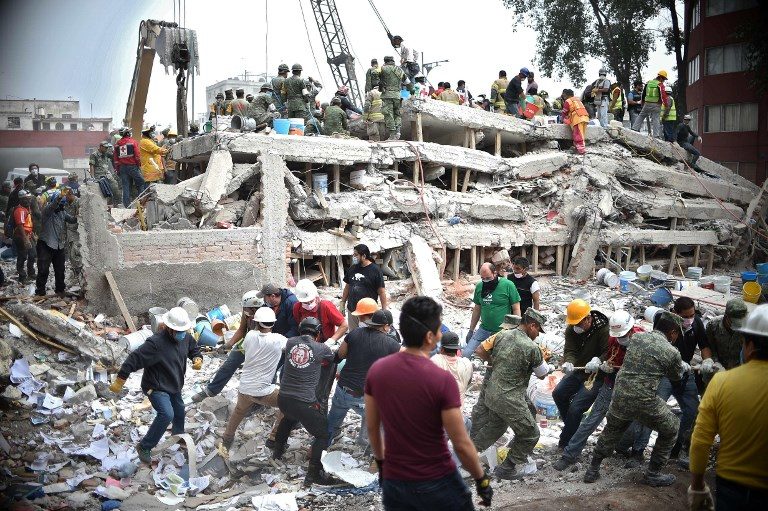SUMMARY
This is AI generated summarization, which may have errors. For context, always refer to the full article.

MEXICO CITY, Mexico – A week after an earthquake that killed more than 300 people, a shaken Mexico was torn Tuesday, September 26, between trying to get back to normal and keeping up an increasingly hopeless search for survivors.
In a nasty twist of fate, last Tuesday’s (September 19) 7.1-magnitude earthquake struck on the anniversary of a 1985 quake that killed more than 10,000 people, the worst in the country’s history.
Improbably, it hit just two hours after an annual earthquake drill, turning Mexico City’s most seismically unstable neighborhoods into something out of a post-apocalyptic movie.
In the trendy Roma neighborhood, shell-shocked and sobbing residents rushed into the street, disoriented and desperate for news of their loved ones – impossible to get in the early minutes, with cell phone networks saturated.
Slowly, a picture of the destruction began to emerge: 39 buildings crumbled to the ground across the capital, trapping hundreds of people inside. Scores more were killed in the states of Morelos, Puebla, Mexico, Guerrero and Oaxaca.
Just as in 1985, thousands of volunteer rescuers sprang into action, scrambling onto the mountains of mangled steel and concrete to dig through the rubble with their bare hands in a desperate search for survivors.
Rescue teams from across Mexico and around the world soon joined them.
Across the city, 69 people were pulled alive from the wreckage in the first days.
But since late Friday, September 22, only bodies have been recovered.
Now the delicate question facing the nation is how long to keep up the search.
‘Our patience is over’
Rescue workers have now wrapped up their efforts at all but 5 sites in Mexico City, and the chances of pulling more survivors from the rubble are dim.
But President Enrique Peña Nieto has been careful to insist that authorities will not send in bulldozers to start cleanup until rescuers are absolutely certain there are no more people in the rubble.
His government has been accused of botching communications with families of the missing.
It faced protests Monday night, September 25, by seething relatives of those still inside the biggest search site, a seven-story office building in the hard-hit Roma neighborhood.
Family members threatened to burst through security barriers and take to the rubble themselves if the authorities did not release more information on the operations inside.
“We acted for 7 days and seven nights peacefully, waiting for results. Our patience is over…. Please update the lists” of bodies recovered, said one relative, Ines Sandoval.
Schools slowly reopen
In a country with a long history of mistrusting official versions of events, the authorities’ communications shortfalls have been widely criticized.
The most notorious incident was at a collapsed primary school where officials said a girl was trapped inside alive.
For nearly two days, the world’s gaze fixated on the remains of the Enrique Rebsamen school.
But on Thursday afternoon, September 21, the Mexican marines said the girl, named as “Frida Sofia” in reports, never existed.
Nineteen children and 7 adults were killed in the school. Like all schools in the city, it had gotten a clean bill of health from the authorities after an earlier quake on September 7.
Now the authorities are inspecting schools again, slowly allowing them to reopen.
Corruption
Mexico City’s mayor, the education minister and the top official for the district meanwhile traded blame after local media reports that the school was built illegally on land reserved for housing.
Education Minister Aurelio Nuno said he had ordered an investigation.
In Mexico City, people began to warily return to work and school.
After nearly a week of eerie quiet in the sprawling city of 20 million people, the capital’s notorious traffic jams were starting to appear again.
But an aftershock that shook Mexico City on Saturday, September 23, has made the country all the more jittery.
Mexico is particularly earthquake-prone, sitting atop 5 tectonic plates.
Many people are still on edge and suffering from post-traumatic stress, said psychologist Raquel Gonzalez, part of a team offering free counseling sessions in a park at the heart of the disaster zone.
“The people who come feel like the ground is still moving. They’re very afraid,” she told Agence France-Presse.
The latest death toll stands at 326 people – 187 of them in Mexico City. – Rappler.com
Add a comment
How does this make you feel?
There are no comments yet. Add your comment to start the conversation.